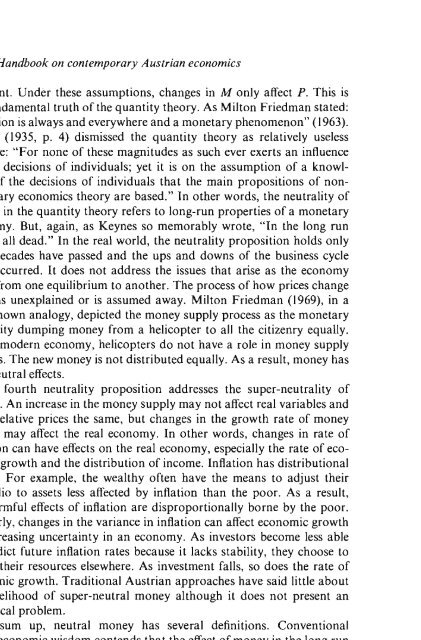Handbook on Contemporary Austrian Economics
Handbook on Contemporary Austrian Economics
Handbook on Contemporary Austrian Economics
You also want an ePaper? Increase the reach of your titles
YUMPU automatically turns print PDFs into web optimized ePapers that Google loves.
114 <str<strong>on</strong>g>Handbook</str<strong>on</strong>g> <strong>on</strong> c<strong>on</strong>temporary <strong>Austrian</strong> ec<strong>on</strong>omics<br />
c<strong>on</strong>stant. Under these assumpti<strong>on</strong>s, changes in M <strong>on</strong>ly affect P. This is<br />
the fundamental truth of the quantity theory. As Milt<strong>on</strong> Friedman stated:<br />
"inflati<strong>on</strong> is always and everywhere and a m<strong>on</strong>etary phenomen<strong>on</strong>" (1963).<br />
Hayek (1935, p. 4) dismissed the quantity theory as relatively useless<br />
because: "For n<strong>on</strong>e of these magnitudes as such ever exerts an influence<br />
<strong>on</strong> the decisi<strong>on</strong>s of individuals; yet it is <strong>on</strong> the assumpti<strong>on</strong> of a knowledge<br />
of the decisi<strong>on</strong>s of individuals that the main propositi<strong>on</strong>s of n<strong>on</strong>m<strong>on</strong>etary<br />
ec<strong>on</strong>omics theory are based." In other words, the neutrality of<br />
m<strong>on</strong>ey in the quantity theory refers to l<strong>on</strong>g-run properties of a m<strong>on</strong>etary<br />
ec<strong>on</strong>omy. But, again, as Keynes so memorably wrote, "In the l<strong>on</strong>g run<br />
we are all dead." In the real world, the neutrality propositi<strong>on</strong> holds <strong>on</strong>ly<br />
after decades have passed and the ups and downs of the business cycle<br />
have occurred. It does not address the issues that arise as the ec<strong>on</strong>omy<br />
shifts from <strong>on</strong>e equilibrium to another. The process of how prices change<br />
remains unexplained or is assumed away. Milt<strong>on</strong> Friedman (1969), in a<br />
well-known analogy, depicted the m<strong>on</strong>ey supply process as the m<strong>on</strong>etary<br />
authority dumping m<strong>on</strong>ey from a helicopter to all the citizenry equally.<br />
In the modern ec<strong>on</strong>omy, helicopters do not have a role in m<strong>on</strong>ey supply<br />
process. The new m<strong>on</strong>ey is not distributed equally. As a result, m<strong>on</strong>ey has<br />
n<strong>on</strong>-neutral effects.<br />
The fourth neutrality propositi<strong>on</strong> addresses the super-neutrality of<br />
m<strong>on</strong>ey. An increase in the m<strong>on</strong>ey supply may not affect real variables and<br />
leave relative prices the same, but changes in the growth rate of m<strong>on</strong>ey<br />
supply may affect the real ec<strong>on</strong>omy. In other words, changes in rate of<br />
inflati<strong>on</strong> can have effects <strong>on</strong> the real ec<strong>on</strong>omy, especially the rate of ec<strong>on</strong>omic<br />
growth and the distributi<strong>on</strong> of income. Inflati<strong>on</strong> has distributi<strong>on</strong>al<br />
effects. For example, the wealthy often have the means to adjust their<br />
portfolio to assets less affected by inflati<strong>on</strong> than the poor. As a result,<br />
the harmful effects of inflati<strong>on</strong> are disproporti<strong>on</strong> ally borne by the poor.<br />
Similarly, changes in the variance in inflati<strong>on</strong> can affect ec<strong>on</strong>omic growth<br />
by increasing uncertainty in an ec<strong>on</strong>omy. As investors become less able<br />
to predict future inflati<strong>on</strong> rates because it lacks stability, they choose to<br />
invest their resources elsewhere. As investment falls, so does the rate of<br />
ec<strong>on</strong>omic growth. Traditi<strong>on</strong>al <strong>Austrian</strong> approaches have said little about<br />
the likelihood of super-neutral m<strong>on</strong>ey although it does not present an<br />
analytical problem.<br />
To sum up, neutral m<strong>on</strong>ey has several definiti<strong>on</strong>s. C<strong>on</strong>venti<strong>on</strong>al<br />
macroec<strong>on</strong>omic wisdom c<strong>on</strong>tends that the effect of m<strong>on</strong>ey in the l<strong>on</strong>g run<br />
is neutral. Changes in the quantity of m<strong>on</strong>ey do not affect real ec<strong>on</strong>omic<br />
variables. Nearly all empirical evidence has supported the claims that<br />
m<strong>on</strong>ey has neutral effects in the l<strong>on</strong>g run. It would seem that the <strong>Austrian</strong><br />
approach to m<strong>on</strong>etary ec<strong>on</strong>omics has little, if any, empirical support.

















